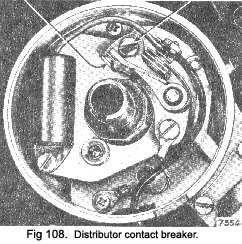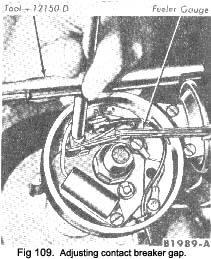
New breaker points—Adjustment
New breaker points can be adjusted with a feeler gauge, scope or a dwell meter.
To adjust the breaker points with a feeler gauge
- Check and adjust the breaker point alignment. Rotate the distributor cam until the rubbing block rests on the peak of a cam lobe.
- Insert the correct blade of a clean feeler gauge between the breaker points (Fig. 109). The gap should be set to the larger opening because the rubbing block will wear down slightly while seating to the cam.
- Apply a light film of distributor cam lubricant to the cam when new points are installed. Do not use engine oil to lubricate the distributor cam
- Set the ignition timing.
If a scope or a dwell meter is used to adjust new points, be sure the points are in proper alignment. Also, set the contact dwell to the low setting. New points must be set to the low dwell as the rubbing block will wear down slightly while seating to the cam.
Used breaker points—Adjustment
If the gap of used breaker points is being checked, use a scope or a dwell meter to test the contact dwell. It is not advisable to use a feeler gauge to adjust or to check the gap of used breaker points because the roughness of the points makes an accurate gap reading or setting impossible. Clean the breaker points. Check the contact
|
dwell with a ‘scope ‘ or dwell meter. The contact dwell, and gap, is given in the Data Section under “Ignition.” Check and adjust the ignition timing.
Alignment
The vented-type breaker points must be accurately aligned and strike squarely in order to realize the full advantages provided by this design, and assure normal breaker point life. Any misalignment of the breaker point surfaces will cause premature wear, overheating and pitting.
- Turn the cam so that the breaker points are closed and check the alignment of the points (Fig. 110).
- Align the breaker points to make full face contact by bending the stationary breaker point bracket (Fig. 108). Do not bend the breaker arm.
- After the breaker points have been properly aligned, adjust the breaker point gap or dwell.
Adjusting spring tension
Correct breaker point spring tension is essential to proper engine operation and normal breaker point life. If the spring tension is too great, rapid wear of the breaker arm rubbing block will result, causing the breaker point gap to close up and retard the spark timing. If the spring tension is too weak, the breaker arm will flutter at high engine r.p.m. resulting in an engine miss.
To check the spring tension, place the hooked end of the spring tension gauge over the movable breaker point.

|
 **
**

